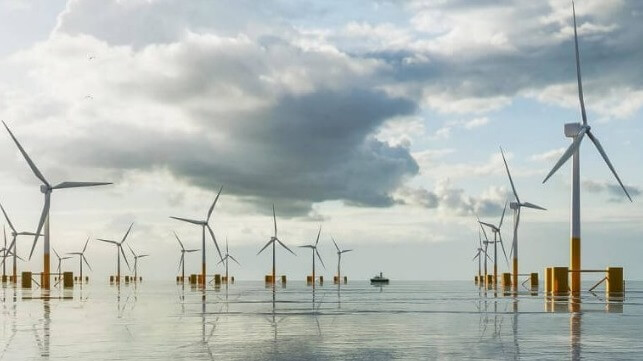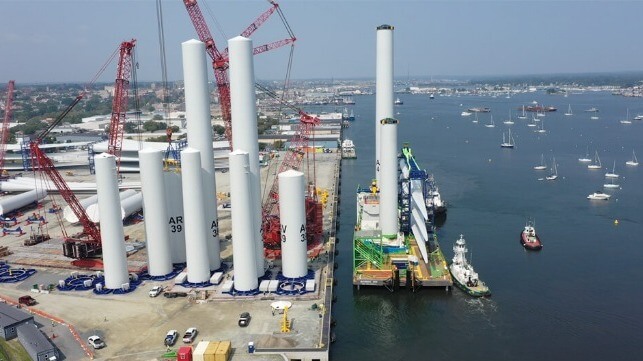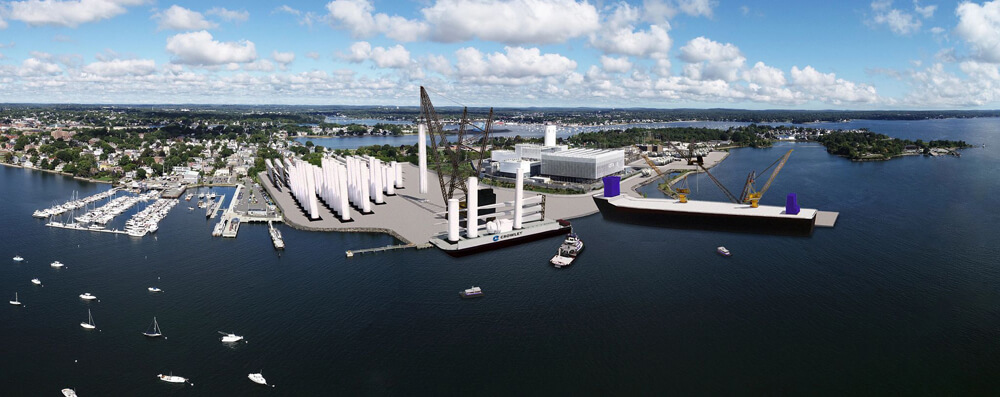Maine Awarded First License for Floating Offshore Wind Research Project

A research effort to develop possibly the first floating offshore wind project in the United States received a research lease today from the U.S. Department of the Interior. It comes almost three years after Maine first filed for the research license to further research projects undertaken by the University of Maine. Maine as a state has moved to bar nearby coastal wind energy instead encouraging it to move further out into the gulf away from its fishing and tourism industries.
The first floating offshore wind lease provides for about 10,000 acres located 28 nautical miles off the coast of Maine on the U.S. Outer Continental Shelf. It is about 45 miles from Portland, Maine. When the state proposed the site, it called the project the next step in research ongoing for more than a decade at the University of Maine to develop floating concrete hull technology for offshore wind turbines.
As a research lease, Maine or its designated operator will propose and conduct research regarding the environmental and engineering aspects of the proposed project. This information will be made public and used to inform future planning, permitting, and construction of commercial-scale floating offshore wind projects in the region. The research lease also allows for the state, fishing community, wildlife experts, and others to conduct in-depth studies and thoroughly evaluate floating offshore wind as a renewable energy source in the region. Information gathered from the research lease the department says will inform commercial floating offshore wind development in the future.
“Floating wind opens up opportunities to produce renewable energy in deeper water farther offshore,” said Bureau of Ocean Energy Management (BOEM) Director Elizabeth Klein. “Signing the Gulf of Maine research lease demonstrates the commitment by both BOEM and the State of Maine to promote a clean energy future for the nation.”
Maine proposed placing up to 12 floating turbines as part of the project. It would have a capacity based on current designs for up to 144 MW of electricity. Construction activity on the research array is not likely to occur for several years. The lessee is first required to submit a Research Activities Plan to BOEM, which will undergo environmental analysis under the National Environmental Policy Act.
Today’s action comes as BOEM has proposed the development of offshore wind in the Gulf of Maine. BOEM outlined an area in a range between 23 and 92 miles off the coast in April 2024 as the first target in the Gulf of Maine. It ranges from Maine to Massachusetts and New Hampshire and they estimate it has a capacity to provide up to 32 GW.
Earlier this year, the Biden administration mapped out the next phase of proposed lease auctions for the offshore wind power industry. This included the Gulf of Maine with a total of 12 additional lease sales planned by 2028. The Department has approved the first nine commercial-scale offshore wind projects with 13 GW of capacity.
The Department of the Interior announced a goal to deploy 15 GW of floating offshore wind capacity by 2035. The administration is providing support for various research efforts designed to lower the cost of deploying floating wind projects.
Crowley Starts Salem Wind Port Project as Massachusetts Expands Wind Ports

Massachusetts is pushing forward with plans to expand its wind port capacities both to support the state's renewable energy plans as well as to make the state a homeport for regional wind energy projects. Efforts kicked off in Salem led by Crowley Wind Services to develop the state’s second dedicated wind port while yesterday MassCEC, the state's clean energy agency, announced plans to expand the current wind port facilities in New Bedford.
The state’s governor and officials are strongly supportive of the wind energy sector. Massachusetts is currently home to projects including the staging for Vineyard Wind 1 as well as other large wind farms. The state however has also found itself the unwelcome recipient of media attention as it works to deal with the debris washing ashore from the blade that fractured in July at the under-development Vineyard Wind 1.
Both New Bedford and Salem are supporting the emerging wind farm industry while plans continue to develop the port capabilities. MassCEC (Massachusetts Clean Energy Center) signed a deal in February 2024 with Crowley Wind Services and the City of Salem which called for the transformation of a former oil- and coal-fired power plant into the Salem Wind Terminal. A ceremonial groundbreaking took place today, August 15, for the project.
“The Salem Wind Terminal will be a historic achievement, and we appreciate the trust and partnership by the City of Salem, Commonwealth of Massachusetts, and the U.S. Maritime Administration to create a world-class wind terminal that reliably and safely serves the supply chain needs of the wind energy industry,” said Tom Crowley, Chairman and CEO, Crowley Corporation. “This public-private partnership in Salem can be a model for communities and the industry to follow to achieve our commitments to create renewable, sustainable power.”

Rendering by Crowley Wind Services of the planned Salem Wind Terminal
The terminal will be one of the few locations capable of supporting the construction and installation of New England’s fixed bottom and future floating offshore wind projects planned for the Gulf of Maine. Crowley will be responsible for redeveloping and operating the terminal. It signed a lease with MassCEC to use the site as an offshore wind marshaling port, with a focus on projects for Massachusetts. The City of Salem has also leased a berth and surrounding land for this purpose. Crowley’s Wind Services will improve the site by adding infrastructure for heavy equipment, constructing a new ship berth, upgrading the city’s existing berth, and dredging the harbor channel. The wind port is expected to begin operating in 2026.
“Coming on the heels of $389 million in federal funds for offshore wind transmission in Somerset, the expansion of the port in New Bedford, and now the groundbreaking in Salem, Massachusetts is well-positioned to support the growing offshore wind industry,” said Governor Maura Healey.
MassCEC also announced plans for the expansion and improvement of the New Bedford Marine Commerce Terminal, a 30-acre facility that is being used for the construction, assembly, and deployment of offshore wind projects. According to officials of MassCEC, the facility is being expanded to support the anticipated increased demand for port facilities that can deploy the larger, heavier turbine parts.
Informed by a strategic planning process and with specific input from offshore wind project developers, wind turbine manufacturers, global marine transportation and installation companies, and port engineering consultants, the project includes the acquisition by MassCEC of four abutting properties, the redevelopment of an existing legacy bulkhead with a new high bearing capacity quayside, and the relocation and construction of a new office and warehouse building. When completed the project will expand the available heavy-lift storage area by a quarter (five acres) to a total of 26 contiguous acres. The project increases the total heavy-lift quayside available at the terminal to 1,200 linear feet and will provide additional office and warehouse space and functionality for terminal tenants
The commonwealth through its Massachusetts Ports Investment Challenge, launched in 2022, made a $180 million investment in a portfolio of offshore wind port redevelopment projects, including funding for the Marine Commerce Terminal expansion project. In total, seven awards were made for projects in New Bedford, Salem, and Somerset, including $45 million for the Marine Commerce Terminal, $75 million for the Salem Offshore Wind Terminal, and funding for Prysmian marine high voltage cables manufacturing facility/terminal and Gladding Hearn Shipbuilding in Somerset. It also aided the North Terminal, Foss Marine Terminal, and Shoreline Marine Terminals in New Bedford.
The efforts are being coordinated to position Massachusetts as a leader in supporting the industry.
No comments:
Post a Comment